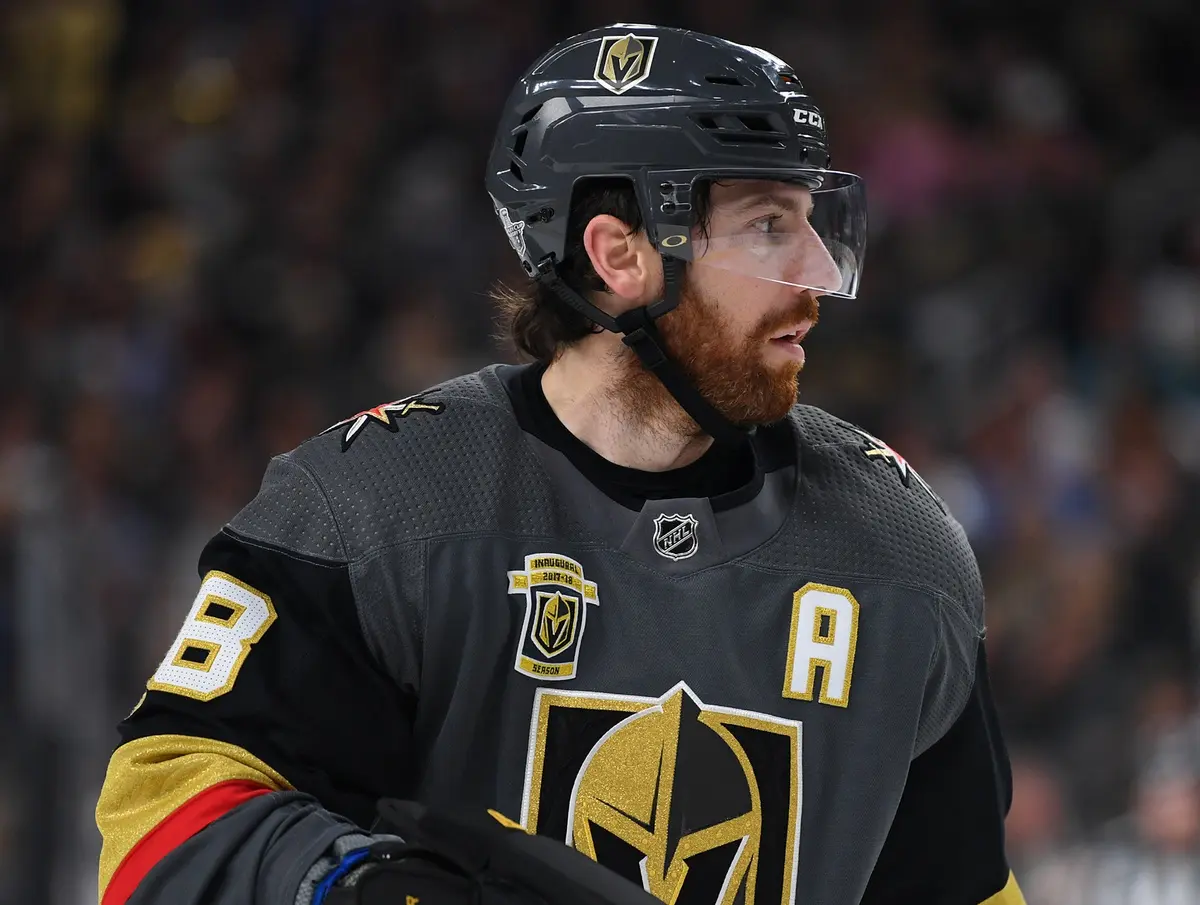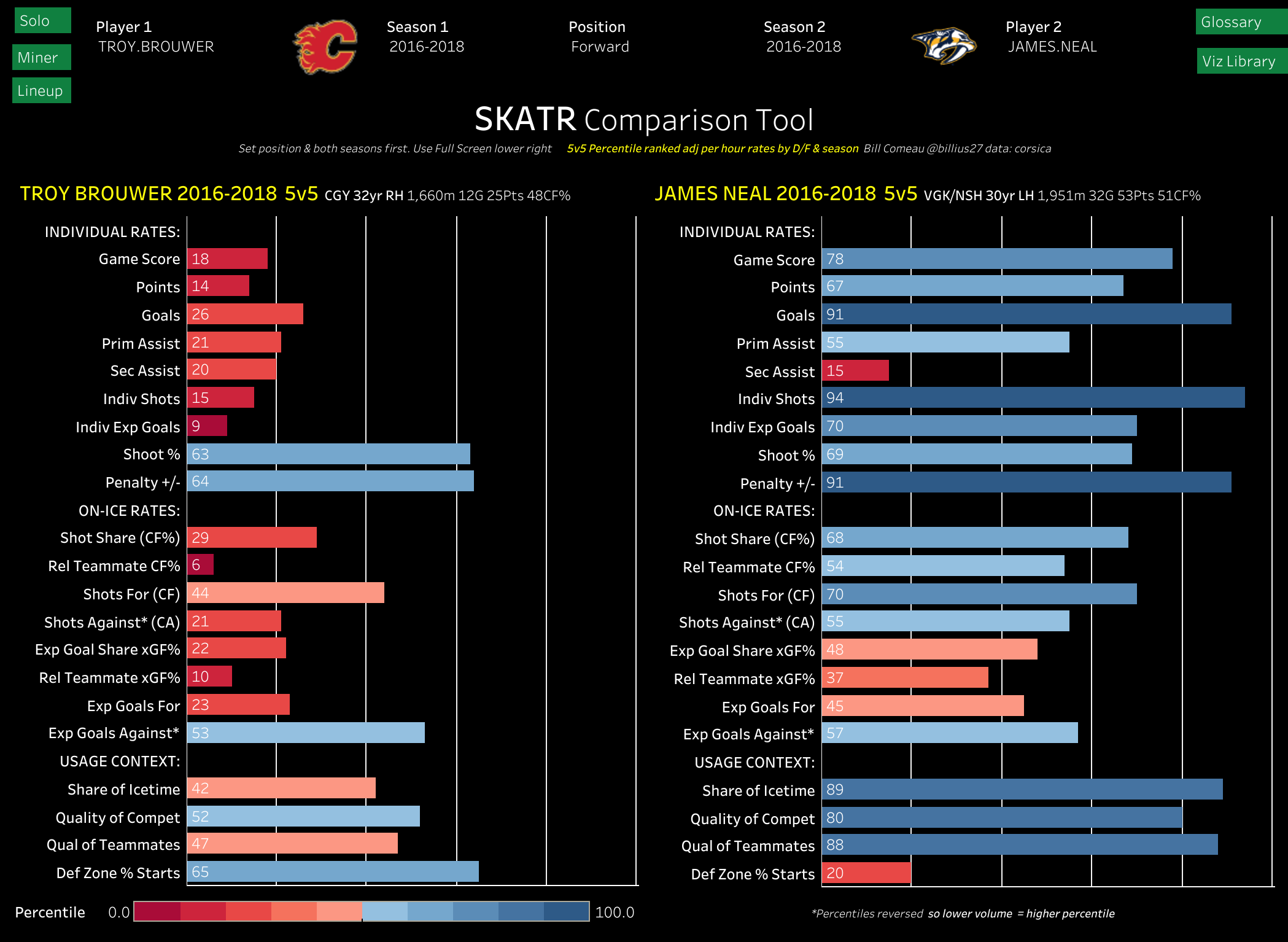James Neal for Troy Brouwer is a good trade for the Flames’ lineup

By Ari Yanover
5 years agoBy deciding to sign James Neal, the Flames effectively pushed Troy Brouwer off of the team. It wasn’t the definitively final nail in the coffin, but it was one of them.
The good news is that, despite the longer contract and higher cap hit, Neal is much more likely to play the role the Flames initially thought Brouwer would.
Free agent signings
To give, you gotta get. Whether it be via trade or free agency, something is taking a hit: in the former you’re giving up something (or someone) valuable, and in the latter, you’re giving up cap space.
| Troy Brouwer | James Neal | |
| Cap hit | $4.5 million | $5.75 million |
| Term | 4 years | 5 years |
| NTC | Yes | No |
The Flames have had a problem: they don’t have any high end right wingers. They haven’t since Jarome Iginla left, really. Not that big a problem when you’re a rebuilding team; a much bigger one when the rest of the lineup is filling out but there’s nobody to complement it on the right side, leaving an entire section of the ice a gaping hole.
To rectify that, the Flames signed a 30-year-old Brouwer (he turned 31 before the season started). He was coming off of a 13-point playoff run, and in addition to his 39 points in the regular season before, he’d also scored 43 in back-to-back years. In Calgary, he never scored more than 25 in a single season, and that he couldn’t live up to expectations was part of the team’s woes in their dismal 2017-18 scoring record that played a key part in them missing the playoffs.
To rectify that, the Flames signed a 30-year-old Neal (he’ll turn 31 before the season starts). He’s coming off of an 11-point playoff run, and scored 44 points in the regular season prior to that (more than Brouwer has ever scored in a single NHL season). Prior to that, Neal has had 41- and 58-point seasons. The initial track record is that much better, hence Neal costing more.
And here’s the kicker: while there were warning signs Brouwer wouldn’t live up to his contract, even though Neal is already in his 30s, he doesn’t face the same issues. That’s not to say he’ll live up to his cap hit his entire contract, but it is to say the Flames should be able to expect, at minimum, a consistent ability to play in the top six for at least a few seasons.
Underlying numbers
A lot of Brouwer’s warning signs could be found in his corsi. No, it’s not the end all, be all of statistics, but it is a handy part of the puzzle one can use to predict future success (or lack thereof). For Brouwer, he was barely ever a 50% player at 5v5: more shot attempts were almost always going against his team than for it whenever he was on the ice. The lone exception was whenever he played a season in which his offensive zone start ratios for the season were over 50%.
Neal is different. His corsi ratings have almost always been over 50%; you have to go back to two of his seasons in Dallas – two of the first three seasons of his career – to find numbers under 50%. However, there is a very notable asterisk to that: Neal has always been a sheltered player relative to his team. His offensive zone start ratios have always been over 50%, and have even topped 60% four times in his 11-year career.
That isn’t necessarily a bad thing, though. This is when you go back to Brouwer and Neal’s raw points totals. While Brouwer has never been afforded the opportunities to score Neal has, that’s probably because he’s just not as good at it. Brouwer is a career .45 point per game player; Neal is a .70 guy. And that’s with Brouwer having a career 13.8 shooting percentage, while Neal has a 12.1% – Neal has taken almost 1,000 more shots than Brouwer over the course of their careers to date, and has scored almost 100 more goals, all while being a little less lucky.
In the same way nobody stresses over Johnny Gaudreau’s performance because he gets favourable offensive zone starts, neither should Neal’s cause concern. They’re scorers. You put scorers in the best position you can to score. That was just never Brouwer’s game.
Both Brouwer and Neal have played for good teams prior to joining the Flames; both have played at least 100 NHL playoff games. By looking at their relative 5v5 corsi results throughout their careers, we can take a glance at just how big an impact they had on their team’s success (numbers via Natural Stat Trick):
| Troy Brouwer | James Neal | |||||||
| Season | Team | ATOI | 5v5 CF rel | 5v5 OZS | Team | ATOI | 5v5 CF rel | 5v5 OZS |
| 2013-14 | WSH | 18:51 | 0.16 | 47.90 | PIT | 18:27 | 10.03 | 56.97 |
| 2014-15 | WSH | 17:31 | -0.70 | 55.01 | NSH | 18:05 | 5.38 | 65.51 |
| 2015-16 | STL | 17:00 | -3.38 | 40.45 | NSH | 19:04 | 1.65 | 60.91 |
| 2016-17 | CGY | 16:13 | -7.52 | 52.32 | NSH | 17:42 | 1.01 | 56.43 |
| 2017-18 | CGY | 13:56 | -3.70 | 41.56 | VGK | 17:11 | -0.51 | 54.38 |
Even when Brouwer was sheltered, he still didn’t perform well; meanwhile, Neal has posted superior results across the board, even though he’s had his advantages along the way. He isn’t the perfect player, and things will probably get worse as his contract goes on – there’s no telling yet if his first negative relative season since his sophomore year is a part of his inevitable decline, or if it was just a blip on the radar – but for the most part, Neal has proven himself reliable for a decade.
Via Bill Comeau’s SKATR Comparison Tool, we can also directly compare Brouwer and Neal over the past two years, over all facets of the game:

Neal is just the better player across the board. He relies less on secondary assists to put up points (a good thing, as a strong majority primary points suggests he’s more involved in creating chances) and he doesn’t start as often in the defensive zone. That’s it.
WOWY impact
Then there’s how each player affects his linemates.
Before signing with Calgary, in 2015-16, Brouwer played for St. Louis. His most common linemates were Paul Stastny, David Backes, and Robby Fabbri:
| CF% w/ Brouwer | Brouwer CF% w/out | Player CF% w/out | |
| Stastny | 50.33 | 49.00 | 55.51 |
| Backes | 49.18 | 50.21 | 52.47 |
| Fabbri | 51.67 | 46.59 | 52.63 |
All players were better away from Brouwer than with him.
During the 2017-18 season with Vegas, Neal played almost exclusively with David Perron and Erik Haula:
| CF% w/ Neal | Neal CF% w/out | Player CF% w/out | |
| Perron | 51.16 | 49.06 | 34.25 |
| Haula | 51.88 | 48.55 | 40.54 |
Neal had a positive impact on his linemates, especially where Perron is concerned.
If you go further back through Brouwer’s seasons, you’ll find he fairly consistently had a negative impact on his linemates’ underlying numbers. Neal, on the other hand, has been a more of a mixed bag: going back through his seasons he and his linemates have often improved one another’s numbers, sometimes Neal has brought a linemate up, and sometimes Neal has brought a linemate down. It’s all really rather average, which is certainly better than consistently negative.
Neal isn’t the perfect signing, particularly as a soon-to-be 31-year-old on a five-year term. But when you dig through his career to date, there’s plenty of evidence that he can still be a productive player, and one much more likely to fill the role the Flames originally thought they’d be paying Brouwer for. He can still score at a top six level. He can still make sure more shots are directed towards the opponent’s net than his own when on the ice. And he can still help improve on his linemates’ performances.
Neal is the better player, and he projects to be the better player in the future. The Flames eventually had to buy Brouwer out, arguably because of Neal’s signing, and they improved their forward lineup by doing just that.
Recent articles from Ari Yanover





